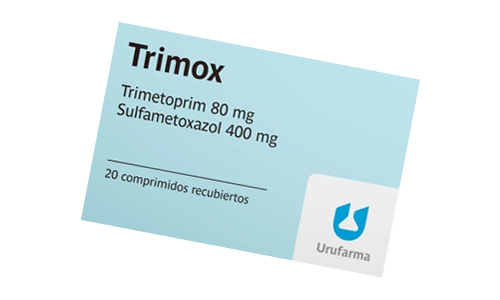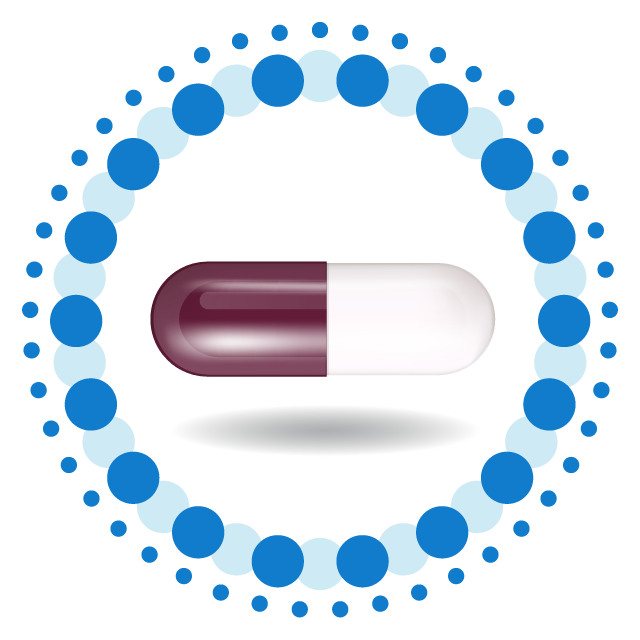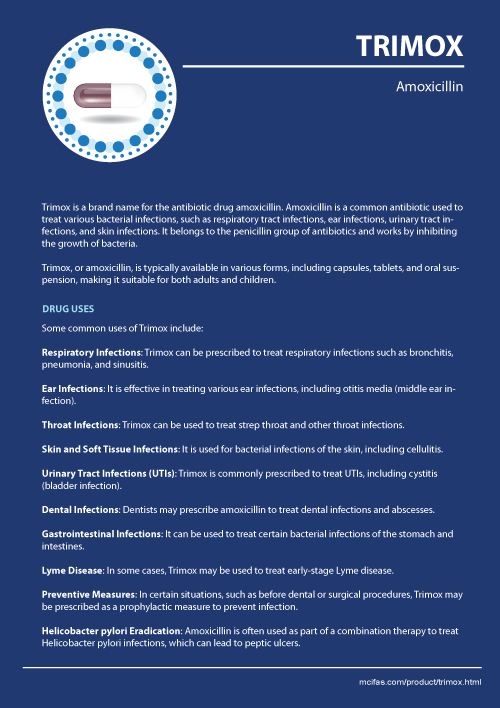Trimox Prescribing Information
Trimox is a brand name for the antibiotic drug amoxicillin. Amoxicillin is a common antibiotic used to treat various bacterial infections, such as respiratory tract infections, ear infections, urinary tract infections, and skin infections. It belongs to the penicillin group of antibiotics and works by inhibiting the growth of bacteria.
Trimox, or amoxicillin, is typically available in various forms, including capsules, tablets, and oral suspension, making it suitable for both adults and children.

Uses of Trimox
Some common uses of Trimox include:
- Respiratory Infections: Trimox can be prescribed to treat respiratory infections such as bronchitis, pneumonia, and sinusitis.
- Ear Infections: It is effective in treating various ear infections, including otitis media (middle ear infection).
- Throat Infections: Trimox can be used to treat strep throat and other throat infections.
- Skin and Soft Tissue Infections: It is used for bacterial infections of the skin, including cellulitis.
- Urinary Tract Infections (UTIs): Antibiotic is commonly prescribed to treat UTIs, including cystitis (bladder infection).
- Dental Infections: Dentists may prescribe amoxicillin to treat dental infections and abscesses.
- Gastrointestinal Infections: It can be used to treat certain bacterial infections of the stomach and intestines.
- Lyme Disease: In some cases, Trimox may be used to treat early-stage Lyme disease.
- Preventive Measures: In certain situations, such as before dental or surgical procedures, Trimox may be prescribed as a prophylactic measure to prevent infection.
- Helicobacter pylori Eradication: Amoxicillin is often used as part of a combination therapy to treat Helicobacter pylori infections, which can lead to peptic ulcers.
Dosage
The appropriate dosage of Trimox can vary depending on the type and severity of the infection being treated, as well as the patient's age, weight, and overall health. The following dosage information is a general guideline and may not be suitable for every individual or situation:
Adult Dosage:
- For most infections: The typical adult dose of Trimox is 250 mg to 500 mg every 8 hours or 500 mg to 875 mg every 12 hours, depending on the severity of the infection.
- For severe infections or respiratory tract infections: Higher doses of up to 875 mg to 1,000 mg every 8 hours may be prescribed.
Pediatric Dosage:
- Pediatric dosing is based on the child's weight and age.
- The dosage may range from 25 mg to 45 mg per kilogram of body weight per day, divided into two to three doses.
Duration of Treatment:
- The duration of treatment varies depending on the type of infection. It can range from a few days to several weeks. It's important to complete the full course of treatment, even if symptoms improve before the medication is finished.
Special Considerations:
- For certain infections, such as urinary tract infections, a shorter course of 3 to 7 days may be sufficient.
- In cases of Helicobacter pylori eradication, amoxicillin is often taken in combination with other medications, and the dosing regimen can be different.
Side Effects of Trimox
Trimox is generally considered safe and well-tolerated when used as prescribed. However, like all medications, it can cause side effects in some individuals. Common side effects may include:
Gastrointestinal Disturbances:
- Nausea
- Vomiting
- Diarrhea
- Abdominal pain or discomfort
Allergic Reactions: While rare, some people may experience allergic reactions to amoxicillin, which can be serious. Seek immediate medical attention if you experience:
- Rash
- Itching
- Swelling, particularly of the face, lips, tongue, or throat
- Severe dizziness or trouble breathing
Yeast Infections: Amoxicillin can disrupt the natural balance of bacteria and yeast in the body, potentially leading to oral or vaginal yeast infections.
Other Common Side Effects:
- Headache
- Dark urine (This can be a benign effect and is not necessarily a sign of liver problems.)
- White patches in the mouth or on the tongue (a possible side effect, but it should be distinguished from oral thrush)
Serious Side Effects: While less common, amoxicillin can lead to more serious side effects, including:
- Severe diarrhea (potentially associated with Clostridium difficile infection)
- Blood disorders, such as a decreased white blood cell count
- Liver problems
- Kidney problems
- Difficulty breathing or wheezing
Interaction with other drugs
Trimox can interact with other drugs, which may affect its effectiveness or increase the risk of side effects. Here are some common drug interactions to be aware of:
- Probenecid: Probenecid can increase the levels of amoxicillin in the blood by reducing its excretion. This interaction is sometimes used deliberately to extend the duration of action of amoxicillin.
- Allopurinol: Allopurinol, a medication used to treat gout, can increase the risk of allergic reactions when taken with amoxicillin.
- Methotrexate: The combination of amoxicillin and methotrexate can increase the risk of methotrexate toxicity. If you are taking methotrexate.
- Oral Contraceptives: There is a theoretical risk that amoxicillin may reduce the effectiveness of oral contraceptives (birth control pills). While this risk is considered low, it's advisable to use an additional form of contraception while taking amoxicillin.
- Anticoagulants (Blood Thinners): Amoxicillin may enhance the anticoagulant effects of drugs like warfarin.
- Other Antibiotics: Combining amoxicillin with other antibiotics, especially those in the same class (such as other penicillins or cephalosporins), can increase the risk of side effects and decrease effectiveness.
What to avoid while on Trimox
When taking Trimox or any antibiotic medication, there are certain precautions and things to avoid to ensure the effectiveness of the medication and minimize the risk of side effects. Here are some important considerations:
- Alcohol: It's generally safe to consume moderate amounts of alcohol while taking amoxicillin. However, excessive alcohol consumption can strain the liver, which may also be processing the antibiotic.
- Dairy Products: Dairy products, such as milk, cheese, and yogurt, can interact with amoxicillin and reduce its absorption in the digestive tract. To ensure optimal absorption, it's best to take amoxicillin at least one hour before or two hours after eating dairy products.
- Grapefruit Juice: Grapefruit juice can interact with various medications, but there is no specific interaction known with amoxicillin.
- Antacids and Acid Blockers: Some antacids and acid-blocking medications, like proton pump inhibitors (PPIs), can reduce the absorption of amoxicillin. If you need to take these medications, it's best to space them apart from your amoxicillin dose.
- Vitamin and Mineral Supplements: High doses of certain minerals, such as calcium, magnesium, and iron, can interfere with the absorption of amoxicillin. If you take supplements, it's a good idea to take them at least two hours before or after your amoxicillin dose.
- Other Medications: Be cautious when taking multiple medications simultaneously.
- Oral Contraceptives: While the risk is low, there is a theoretical possibility that amoxicillin may reduce the effectiveness of oral contraceptives (birth control pills). Consider using an additional form of contraception during your course of amoxicillin treatment.
- Driving and Operating Machinery: Amoxicillin itself is not known to cause drowsiness or impair driving skills. However, if you experience side effects like dizziness or confusion while taking amoxicillin, it's advisable to avoid activities that require mental alertness until you feel well again.
Contraindications of Trimox
Trimox is generally considered safe and effective for the treatment of bacterial infections when used appropriately. However, there are certain contraindications, or situations in which the use of Trimox should be avoided or carefully evaluated, due to potential risks. Contraindications may include:
- Allergy to Penicillins: Trimox is a member of the penicillin class of antibiotics. Individuals with a known allergy to penicillins or other beta-lactam antibiotics should not take Trimox unless under close medical supervision. Allergic reactions to penicillins can range from mild skin rashes to severe anaphylactic reactions, which can be life-threatening.
- Severe Allergic Reactions to Amoxicillin: If a person has previously experienced a severe allergic reaction to amoxicillin or other penicillins, it is generally contraindicated to use this medication again, as the risk of a severe allergic reaction is significantly increased.
- Infectious Mononucleosis (Mono): Using amoxicillin in individuals with infectious mononucleosis (mono) caused by the Epstein-Barr virus can result in a rash known as an amoxicillin rash. This rash is not an allergic reaction but is a known side effect of amoxicillin in people with mono.
- Liver Disease: Individuals with severe liver disease may require dosage adjustments or alternative antibiotics because amoxicillin is primarily metabolized by the liver.
- Kidney Disease: People with significant kidney disease may require dose adjustments or alternative antibiotics. Amoxicillin is excreted by the kidneys, and if kidney function is impaired, it can lead to higher blood levels of the drug.
- Certain Medical Conditions: Individuals with certain medical conditions, such as colitis (inflammation of the colon) or a history of gastrointestinal problems related to antibiotics, should use Trimox with caution, as it can potentially worsen these conditions.
- Interaction with Methotrexate: Amoxicillin can interact with methotrexate, a medication used to treat various conditions, including cancer and rheumatoid arthritis. The combination may increase the risk of methotrexate toxicity, so caution and monitoring are required.
Pregnancy and Trimox
Trimox is generally considered safe for use during pregnancy when prescribed and when the benefits of treatment outweigh the potential risks. Pregnant individuals can develop bacterial infections just like anyone else, and in some cases, it's essential to treat these infections to protect both the mother and the developing fetus.
Here are some key considerations regarding the use of Trimox during pregnancy:
- Infection Risks: Left untreated, bacterial infections during pregnancy can pose risks to both the mother and the baby. These risks can include preterm labor, low birth weight, and the potential spread of infection to the developing fetus. Therefore, it is important to address bacterial infections in pregnant individuals promptly.
- Safety Profile: Amoxicillin, the active ingredient in Trimox, is considered one of the safer antibiotics for use during pregnancy. It has been widely used for many years, and there is a substantial body of evidence suggesting that it does not significantly increase the risk of birth defects or other adverse outcomes.
- Dosage and Duration: It's essential to follow their instructions precisely and complete the full course of antibiotics, even if you start feeling better before finishing the medication.
- Breastfeeding: Amoxicillin is generally considered safe for use during breastfeeding, as only small amounts pass into breast milk.
» Drug Uses (format pdf, 0.2 Mb)



